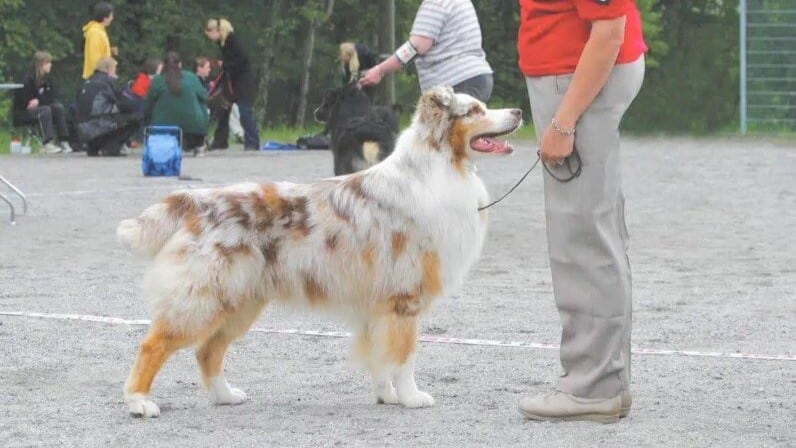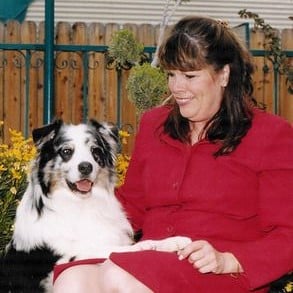
Home » The Australian Shepherd – Tales About No Tails

With the advent of tail docking bans in Europe, every docked-tail breed of dog in the United States has been dealing with the potential of a full-tailed dog exhibiting in the AKC breed ring. Breed clubs have been issuing statements for years on their points of view of this trend, clearly stating how they wish AKC judges to appropriately judge a tailed exhibit… the Australian Shepherd is no different. Or are they?
Compared to breeds that have a known and documented history that span centuries, the Australian Shepherd is a relatively new member to the world of purebred dogs. Developed almost exclusively by ranchers and farmers in the western US, an accurate record of the breed development remains elusive and unknown. We do not even truly know how the breed became known as the “Australian” Shepherd.
Suffice to say that ranchers who needed dogs to work and fill a specific chore on the ranch quickly were enamored with the eye-catching “little blue dogs.” Photographic evidence shows Aussie look-alikes throughout the 1800s, especially after the 1840s. In all likelihood, the breed developed coincidentally with the human immigration at the time. However the breed history was never completely captured. Ranchers mated selected superior working animals with other superior specimens, creating offspring and generations that worked, but had no official registry. Oftentimes it resulted in different breeds or even cross-bred dogs being used on each other to produce superior working stock. The focus was on an improved working dog.
Recently the United States Australian Shepherd Association (USASA) board approved a statement on the judging of tailed Australian Shepherds in the United States. The statement was clear that any exhibit with a tail longer than four inches (as called for in the breed standard) is to be faulted. It is clear that it is a judge’s job to determine how that fault should be applied to the dog as a whole. In order for a judge to be able to do justice to this breed it is important to know the history of the breed regarding no tails. This is not a simple case of a docked-tail breed showing with a full tail… far from it. A key point is that this is NOT solely a docked-tail breed. This breed originated as a natural bob-tail.
The docking option was included to maintain breed type and uniformity. The earliest written and approved breed standard available is from 1959. The Animal Research Foundation (ARF) standard was written by Mr. and Mrs. Don R. Breazeale, pioneer breeders of the “Australian Shepherd Blue Heeler.” This standard was adopted and published in the 1959-1960 Winter Edition of Tom Stodghill’s Animal Research Magazine. “TAIL: Should be on level with body. Always natural bobtail. Long tails are permissible but not desirable and should be cut off.”
The intent of the breed founders is clear. This is a natural bob-tail breed first and foremost. It is important to note that this breed does not just come as a natural bob-tail or a full tail. In reality the breed can produce tails of varying lengths. This is different than other docked-tail breeds. It is generally considered that we started docking for uniformity and to address the tails of all varying lengths. The next and most impactful mention of the importance of the natural bob tail for the Australian Shepherd is in a subsequent breed standard, published by ARF in the 1960s. It goes into great detail about the natural bob tail, including breeding advice to preserve the breed featured trait, a description devoid in modern breed standards: “Tail: The tail should always be a natural bob—the shorter the better—but not tailless.
Purebred Australian Shepherds will produce a high percentage of puppies with natural bob tails. These natural bobs will vary all the way from a two-inch tail bone to about one-half the length of the normal tail length of other breeds. Aussies retained for breeding purposes should be selected for the natural bob factor—again, the shorter the better. Other things being equal, no Aussie should be used for breeding if it has a tail more than one-fourth the normal length. Long-tailed
Aussies should never have a tail in which the bone reaches below the hock point of the rear leg. Pups’ tails over one-fourth normal length should be docked shortly after birth. Owners and breeders of good Aussie bitches should always base their breeding programs on a foundation or ‘hub’ stud which has a natural bobtail in which the bone is no longer than two or three inches. Only through this type of selective breeding can the true type of Australian Shepherd be produced. Faults: long tails, tails over one-fourth normal length, tails of any length where the bone is twisted or ‘screwed.’ the bone must be straight, with not a hint of kinking or swirling.”
Never has a more clear statement about the importance of the natural bob tail trait in the Australian Shepherd been written. While this expansive statement was eliminated from later versions of the breed standards, it is important in terms of the breed’s development. It is equally important for judges (and breeders) to know in order to preserve and protect the breed and breed type going forward. It is important to note that the first official breed club, The Australian Shepherd Club of America (ASCA) was not formed until the 1950s and one of their first formal breed standards was approved in 1968. Their wording on tails is abbreviated from the detailed description of their predecessors, but their intention on the preservation of the natural bob tail remains clear. “Tail: Should be natural bob, or on long tails should be docked for working dogs.”
In the 1960s the International Australian Shepherd Association was formed on the west coast also with the intention of gaining AKC approval for the breed. Their first breed standard, adopted in 1969 states, read as follows. “Tail: The tail is an extension of the spine; natural bob or docked. A tail longer than four inches at maturity shall disqualify in the conformation ring.” Their wording is clear on a full-tailed exhibit—it was enough of a distraction from the breed to be designated as a disqualification.
In 1967 the Animal Research Foundation revised their standard and in conjunction with ASCA they conjointly approved a 1970s version of the breed standard. It is important to note that they retained the previous long and detailed description in the tail section of earlier standards, clearly stating how to breed the animals to maintain the trait. In the 1960s and 1970s the docked-tail option surfaced as there was some evidence that breeding natural bob tails to natural bob tails (NBT to NBT) might produce birth deformities such as spina bifida (a shortening of the spine).
To this day no clear scientific evidence proves this. There are theories that NBT to NBT fetuses might be absorbed in utero, but no clear evidence of birth defects other than theory. The misunderstood and unfortunate use of the term “lethal,” used by geneticists in describing the NBT gene, has caused mass hysteria overseas where the practice of NBT to NBT breeding has been banned, thus removing a key characteristic of the Australian Shepherd. Keep in mind that the “merle” gene, also a hallmark of this breed, is also a target for elimination overseas. Talk with modern founding breeders (all of whom have had 50 years’ experience breeding quality and consistency over time) and they all state that they have been breeding NBT to NBT for this entire time with little or no defects.
Three noted that the one or two times (in 50 years!) that they had issues were with naturally very short-tailed dogs being bred to like dogs. They made note of the issue and easily bred away from it in the future. It is not until the 1975 revision that the ASCA breed standard leaves out the detailed explanation of the natural bob tail in the breed. This is in keeping with ASCA’s reliance on and use of the AKC guidelines for writing breed standards and they came up with the following. “Tail is straight, not to exceed four (4) inches, natural bobtail or docked.” The current AKC breed standard states, “Tail is straight, docked or naturally bobbed, not to exceed four inches in length.”
This simplified statement on tails is what you will use when you judge the breed, but as you can see, it does not tell the entire story of the breed. Another unique aspect of the tail in the Australian Shepherd is that this breed was developed solely in the United States. The foundation stock, the breed history and development resides here. Unlike other “docked tail” breeds (hopefully the evidence is clear that this is not solely a docked-tail breed) in the US, our breeders do not face pressure to import bloodstock from outside of the US, thus putting pressure on the breed club to accept full-tailed exhibits in the breed ring. The popularity of the Australian Shepherd has exploded worldwide, but I see no genetic need to import full-tailed dogs from overseas.
This sets this breed apart from others you may judge with full tails; breeds that need to import additional foundation stock. The tale about the Australian Shepherd tail is entwined in our short breed history. The natural bob tail aspect of the breed is one of the unique and identifying breed characteristics. The parent club has made it clear that they wish to preserve and protect this aspect of the breed. We ask that you as judges and breeders assist in the preservation of the Australian Shepherd breed and breed type.
The Australian Shepherd is a natural bobtail/ docked tail breed. At this time the USASA has no immediate plans to amend its breed standard on this issue because no ‘official’ description of the undocked Australian Shepherd tail exists. The standard currently states under General Appearance, “He has a docked or natural bob tail.” The standard continues under the Neck, Head, Body section to state, “Tail is straight, docked or naturally bobbed, not to exceed four inches in length.” One of the unique characteristics of the Australian Shepherd is that they are not solely a docked tail breed, but also a natural bob tail breed.
Dogs can be born with all varying lengths of tail…from natural bob to full tail… AND all lengths in between; hence the reason for the standard reference above regarding a tail to be less than four inches in length. We prefer the natural bob tail and we dock for uniformity and breed type. While it is understood that you as a judge have a choice, the USASA prefers that you consider an Australian Shepherd with a full tail to be a serious deviation from the standard and breed type and prioritize and penalize it accordingly.
Any deviation from the ideal described in the standard should be penalized to the extent of the deviation. For instance, a tail that is six inches in length would be faulted over a dog with a tail that is less than four-inch inches. A full tail would be more severely faulted. The natural bob tail/docked tail is an identifying breed characteristic and essential to preserving our breed type. As a judge you should place great importance in how the structure functions in movement (gaiting), but, in the final analysis, you should go back to type (the sum of them all) in determining your placements. We wish to preserve the history and heritage of this breed. The essence of a breed should not be forgotten.
Sincerely,
Terri Morgan, USASA President
Flo McDaniel, USASA Judge’s Education Coordinator
The Australian Shepherd is a natural bob-tail/docked tail breed. At this time the ASCA has no immediate plans to amend its breed standard on this issue. We are aware of a trend among breeders in the United States to assume that leaving a tail on an Australian Shepherd and registering that dog with ASCA is an “option” or a “right.” You have not been granted that option from ASCA. The standard currently states under General Appearance, “An identifying characteristic is his natural or docked/bobtail.“ An identifying characteristic in ANY breed standard is a major and unique identifying characteristic and is not to be discarded or thought of lightly.
It is what makes our breed unique and different from other breeds. While our breed is an American-developed breed and while we enjoy numerous freedoms as Americans, including the choice to leave tails on Australian Shepherds, this does not inherently entitle one to register that animal with ASCA. The standard continues under the Neck and Body section to state, “Tail is straight, docked or naturally bobbed, not to exceed four inches in length.” The natural bob tail/docked tail is an identifying breed characteristic and essential to preserving our breed type.
As breeders you should place great importance in the current approved breed standard and all that it contains. It is the blueprint to preserve our breed, not change it unilaterally upon a whim or personal feelings. One of the unique characteristics of the Australian Shepherd is that they are not solely a docked tail breed, but also a natural bob-tail breed.
Aussies can be born with all varying lengths of tail…from natural bob to full tail…AND all lengths in between; hence the reason for the standard reference above regarding a tail to be less than four inches in length. We choose to preserve the natural bob tail and we dock for uniformity and breed type (unique identifying breed characteristic). We wish to preserve the history and heritage of this breed. The essence of a breed should not be forgotten and the breed standard should command the respect that it deserves.
The Australian Shepherd Club of America will not condone the policy of any individual, group or proposed legislation which advocates restricting the breeding, showing, training and/or exhibiting of the Australian Shepherd or any other domesticated animal. The Australian Shepherd Club of American also does not condone the proposed restrictions to the practice of tail docking or removal of dewclaws for cosmetic or health reasons. We find this policy to be a detriment to the welfare of the Australian Shepherd breed as a whole and an infringement on the rights of the owners, breeders, trainers and exhibitors of all domesticated animals. The Australian Shepherd Club of America will educate its members of any proposed legislation which may ill affect the welfare of the breed and its guardians, the breeders, owners, trainers and exhibitors.
